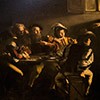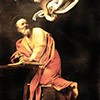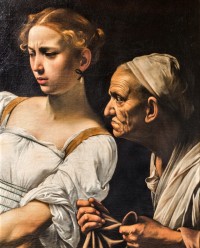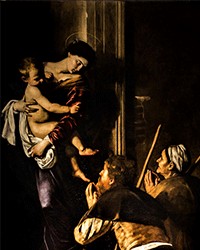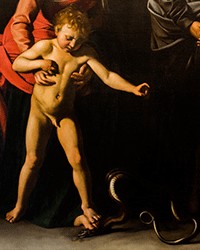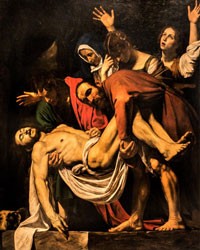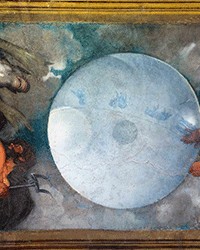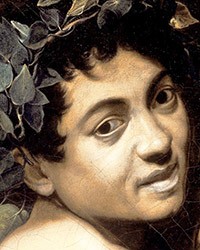Caravaggio (1571–1610) - a subtle interpreter of the Bible and a common criminal
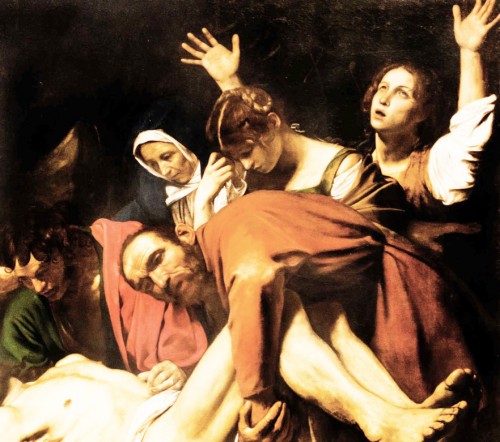
Caravaggio, The Entombment of Christ, fragment, Musei Vaticani
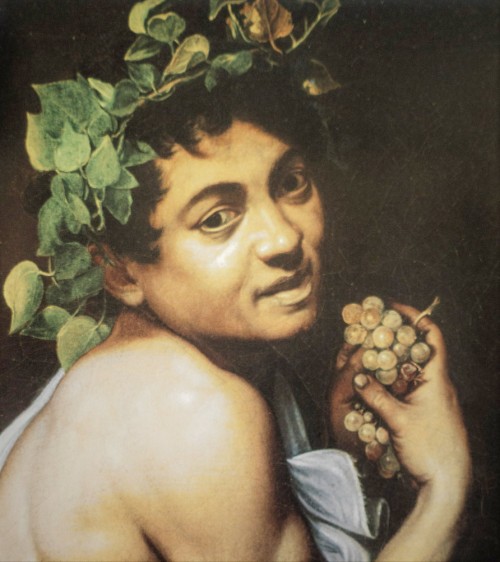
Caravaggio, Young Sick Bachus, fragment, Galleria Borghese
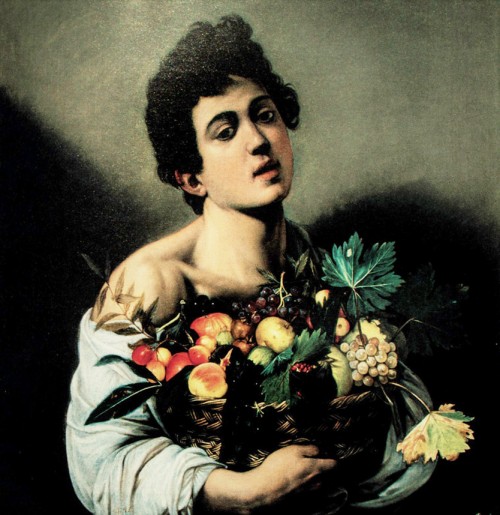
Caravaggio, Boy with a Basket of Fruit, Galleria Borghese
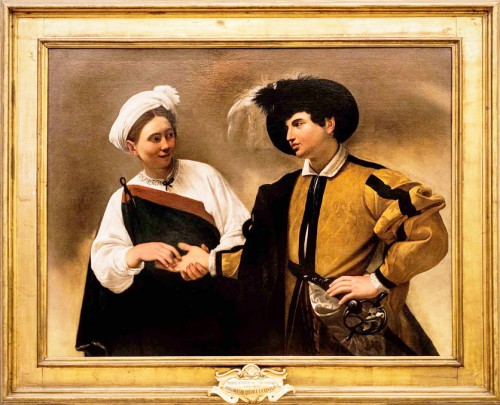
Caravaggio, The Fortune Teller, Musei Capitolini
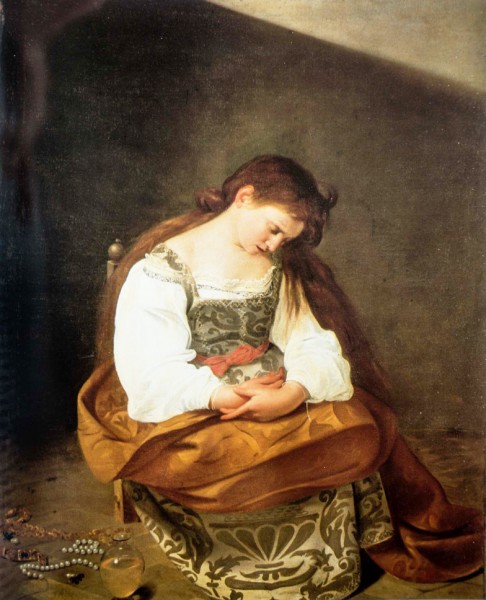
Caravaggio, Repentant Mary Magdalene, Galleria Doria Pamphilj
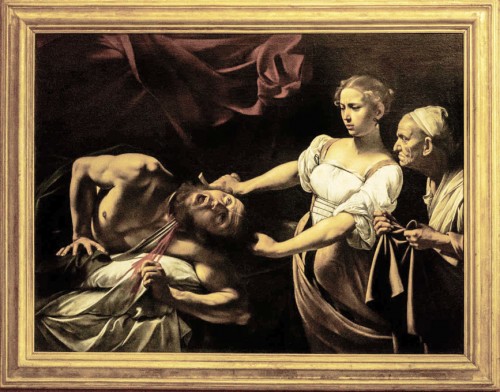
Caravaggio, Judith Beheading Holofernes, Galleria Nazionale d’Arte Antica, Palazzo Barberini
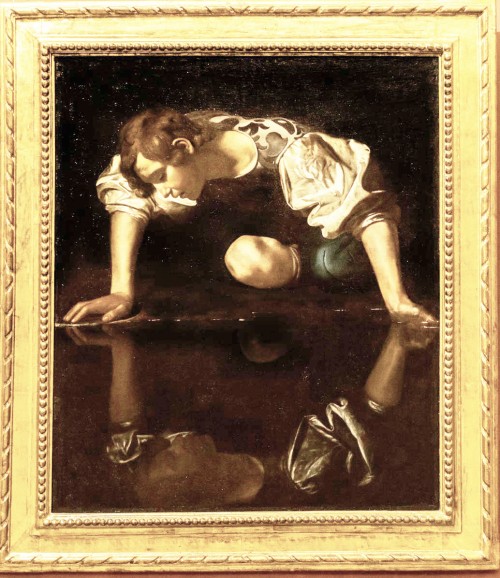
Caravaggio, Narcissus Galleria Nazionale d’Arte Antica, Palazzo Barberini

Caravaggio, The calling of St. Matthew, Contarelli Chapel, Church of San Luigi dei Francesi
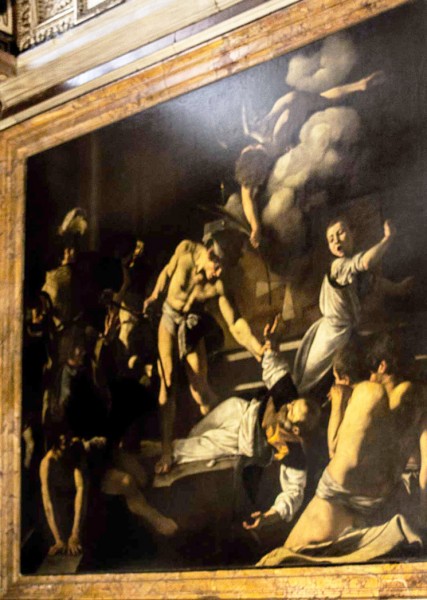
Caravaggio, The Martyrdom of St. Matthew, Contarelli Chapel, Church of San Luigi dei Francesi

Caravaggio, St. Matthew the Evangelist, Basilica of San Luigi dei Francesi
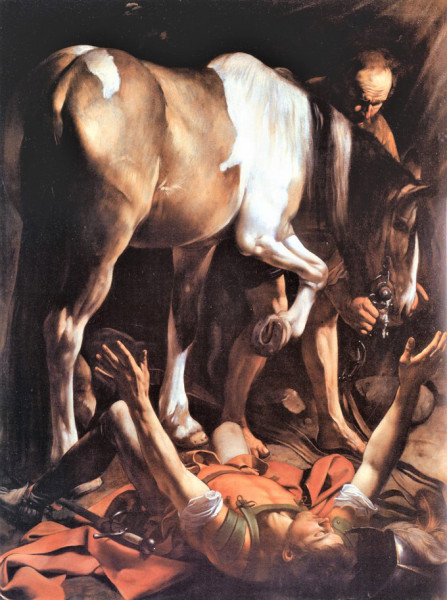
Caravaggio, The Conversion of Saul, Cerasi Chapel, Basilica of Santa Maria del Popolo
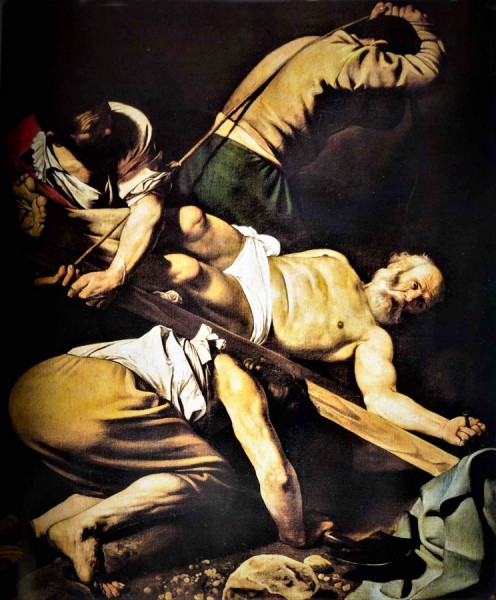
Caravaggio, The Martyrdom of St. Peter, Cerasi Chapel, Basilica of Santa Maria del Popolo
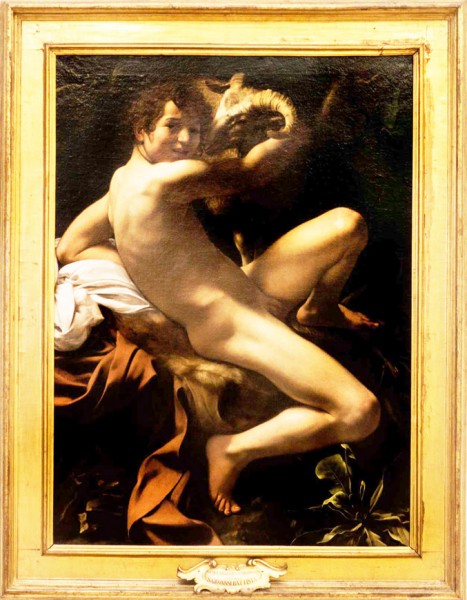
Caravaggio, St. John the Baptist, Musei Capitolini
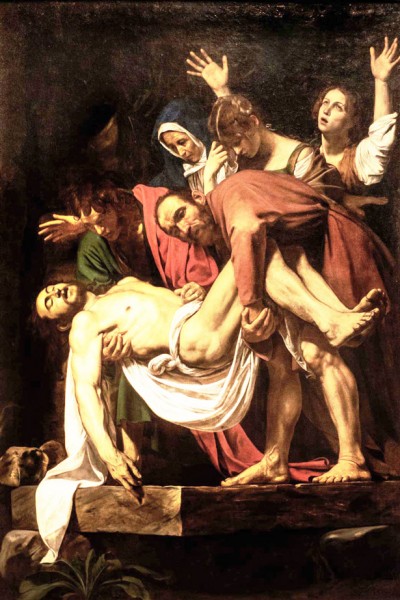
Caravaggio, The Entombment of Christ, Musei Vaticani
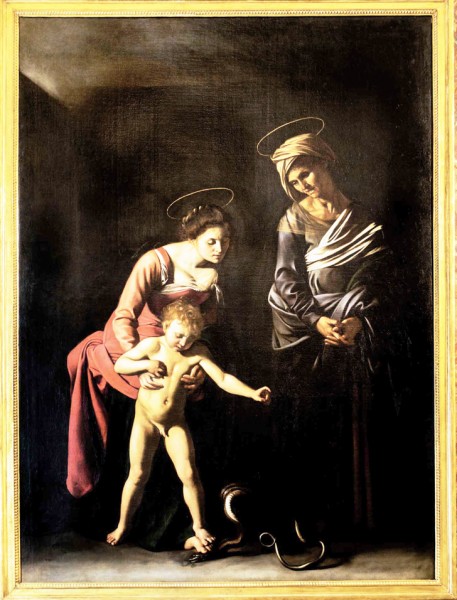
Caravaggio, Madonna dei Palafrenieri, Galleria Borghese
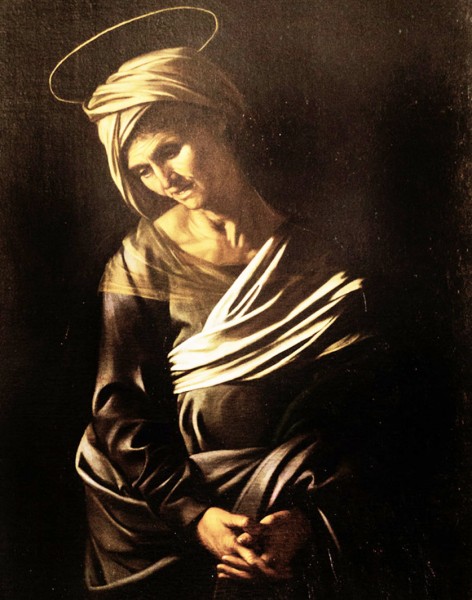
Caravaggio, Madonna dei Palafrenieri, fragment, St. Anne, Galleria Borghese
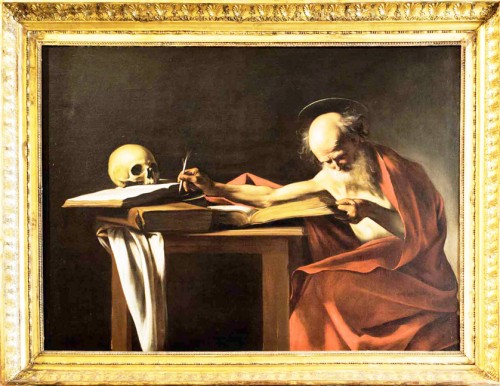
Caravaggio, St. Jerome, Galleria Borghese
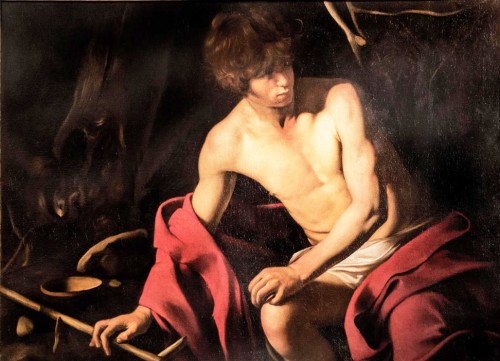
Caravaggio, John the Baptist, Galleria Nazionale d’Arte Antica, Palazzo Corsini
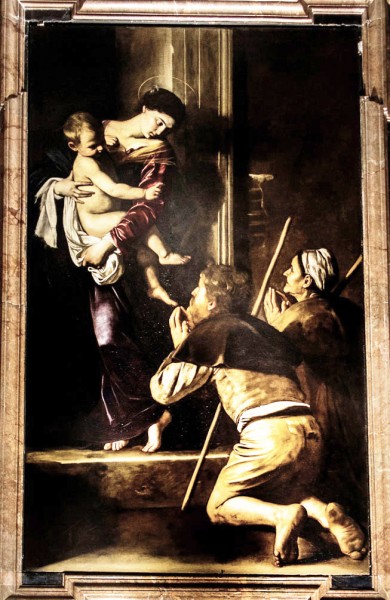
Caravaggio, The Loreto Madonna, Basilica of Sant’Agostino
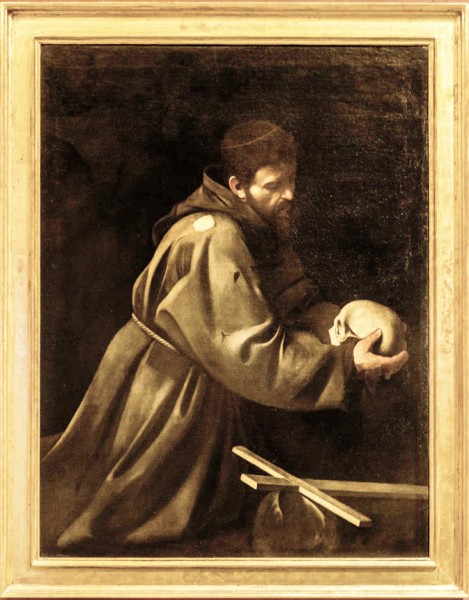
Caravaggio, Saint Francis, Galleria Nazionale d’Arte Antica, Palazzo Barberini
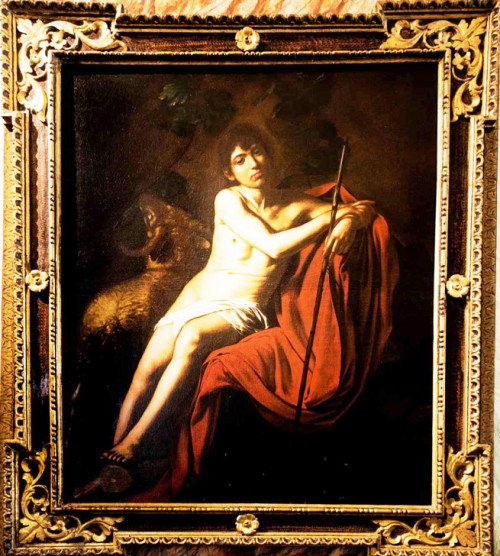
Caravaggio, John the Baptist, Galleria Borghese
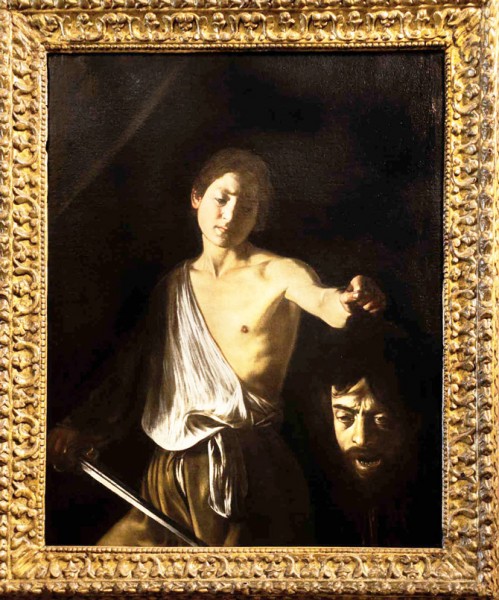
Caravaggio, David with the Head of Goliath, Galleria Borghese
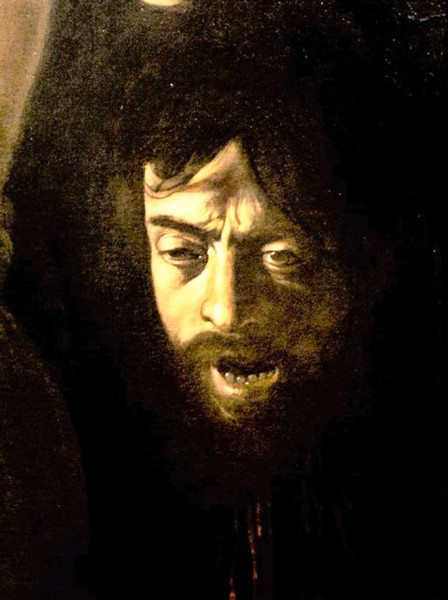
Caravaggio, David with the Head of Goliath, fragment, alleged self-portrait of the artist, Galleria Borghese
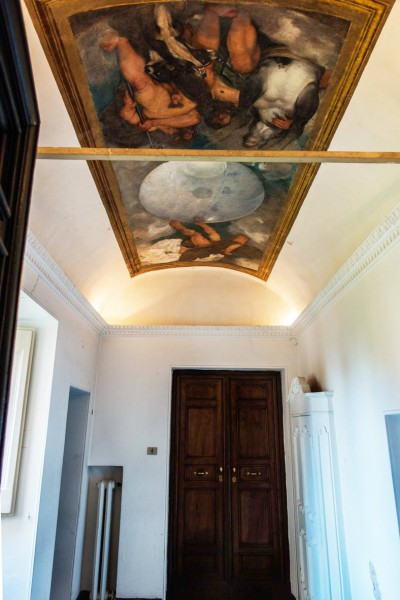
Casino Ludovisi, the interior of the alchemical study of cardinal del Monte
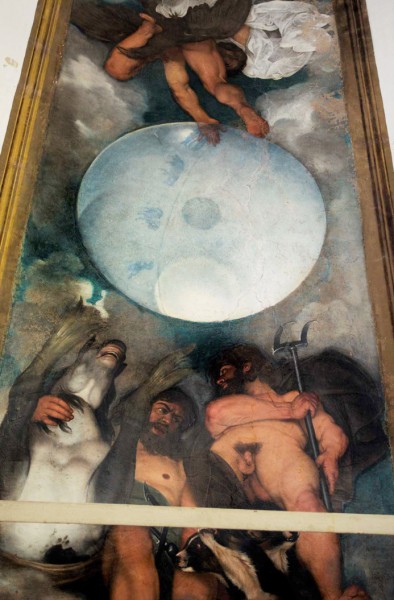
The ceiling painting depicting the Olympian Gods, Casino Ludovisi
He was a genius of his epoch, a painter of beautiful youths, veristic still life, but most of all moving, full of deep spirituality and faith, religious paintings. In his contemporaries he aroused as much antagonism as admiration. At the same time like no other artist, through his unbalanced personality, which caused constant conflicts with the law, he himself blocked his path to a successful career. He was a bon vivant, a murderer, a runaway suspected of pedophilia, sentenced and pardoned multiple times thanks to the intercession of wealthy protectors, fascinated by his talent.
He was a genius of his epoch, a painter of beautiful youths, veristic still life, but most of all moving, full of deep spirituality and faith, religious paintings. In his contemporaries he aroused as much antagonism as admiration. At the same time like no other artist, through his unbalanced personality, which caused constant conflicts with the law, he himself blocked his path to a successful career. He was a bon vivant, a murderer, a runaway suspected of pedophilia, sentenced and pardoned multiple times thanks to the intercession of wealthy protectors, fascinated by his talent.
He was born in Milan learning to paint there and at the age of twenty, after a short trip, which was even then probably the result of some legal problems, he landed in the then center of art, meaning Rome. He began working at the side of the famous painter Cavalier D’Arpino (Giuseppe Cesari). In his workshop he executed copies of paintings, workshop tasks of little significance and flower garlands. Due to unknown circumstances he left Cesari’s atelier and started working on his own, which meant selling paintings in the least attractive way possible – through city vendors. Valued and noteworthy artists were under the patronage of wealthy patrons, which gave them not only a stable income and a place to live, but also the prestige connected with being part of the court of a given dignitary, generally from the church. For Caravaggio this happened to be Cardinal Francesco Maria del Monte, but it happened a lot later. It was for the cardinal and a circle of his friends that he painted the images of handsome youths and musicians – intimate, meant for private contemplation. Even though, Caravaggio’s life stabilized, he still engaged – along with his equally frivolous friends, such as the architect Onorio Longhi, or the painter Orazio Gentileschi – in street fights, tavern quarrels, not refraining from using a sword or a dagger. The second weapon in his arsenal which he often used was slander, which many of his fellow painters experienced. He considered himself, which he underlined multiple times, a man of honor, which in his case was simultaneous with being truculent, aggressive and arrogant – that is how his earliest biographers describe him. One of them, Gian Pietro Bellori, wrote: “Caravaggio's style corresponded to his physiognomy and appearance; he had a dark complexion and dark eyes, and his eyebrows and hair were black; this coloring was naturally reflected in his paintings."
The artist’s behavior characterized high-born people, of whose circles he certainly wanted to be a part. The elite game of pallacorda (tr. early form of tennis), refusal of commissions, defiant way of being – all this made him a knight with the status of a craftsman, who clearly felt badly inside his own body. He was distant from his family as well – Caravaggio’s brother, a Jesuit priest, when visiting him in the cardinal’s palace was left standing at the door – the painter stated that he does not know him. Thanks to the intercession of Cardinal del Monte, the possibility to sail out onto the open waters of art opened up in front of Caravaggio, since that is what narrative, religious painting guaranteed. He got a commission from the executors of the testament of Cardinal Matteo Contarella. In the national church of the French, San Luigi dei Francesi (Church of St. Louis of the French) in Rome, he was to complete three paintings, decorating the chapel funded before his death by said clergyman (Contarelli Chapel). For the unexperienced in multi-figure scenes painter, it was the first big commission with which he was supposed to prove his talent. Following ones, including one for the Church of Santa Maria del Popolo, confirmed his position making him the most famous painter in Rome.

In his paintings Caravaggio distanced himself from the theory and art of the principal and notable Roman painters, such as Federico Zuccari and Giuseppe Cesari. He went against the prevalent in art of that time mannerism and its tendency to idealize. He strived for the truth, which he discovered on the street, in Roman inns and among the ugly and rejected creatures which resided within. His disciples and martyrs, as if cast off the clouds, are nothing like heroes – they wander Roman alleys, fear and suffer just like people, their miracles happen inconspicuously. On the other hand simple people on his canvas, with dirty hands and rugged feet, often stigmatized with sin and weakness, can be sure that they too will obtain forgiveness and salvation.
Apart from altar paintings Caravaggio continued to paint compositions destined for private apartments – two of them seem to be of particular interest. The first one depicts Amor Victorious (1602, Berlin, Staatliche Museen), the second – a near twin – St. John the Baptist (Musei Capitolini); both the protagonists have something exceptionally homoerotic in them.
During the last years of his stay in Rome, Caravaggio’s art oscillated between coarseness of the world of street merchants, beggars and pilgrims with faces plowed with rapid aging, and seductive, sensual boys, given to courtly games, whose images were just what the subtle tastes of aristocrats desired. Despite the renown and fame he possessed, or perhaps because of them, the artist’s behavior did not change. He still had problems with the law, he was imprisoned multiple times and released time and time again. A real blow for him was the fact that clients refused two of his important paintings. The first canvas which was heavily criticized was the Death of the Virgin (Louvre, Paris), the second Madonna and Child with St. Anne (Madonna dei Palafrenieri).

More or less at the same time, he was charged with the murder of a police sergeant, was once again thrown into prison and had to flee the city, in which he was aided by Cardinal Scipione Borghese. Thanks to his protectors Caravaggio returned to Rome, to continue painting, but soon afterwards during a quarrel he killed his adversary. Once again he had to escape, in order to find himself outside the pope’s jurisdiction. This time however, he became an outlaw and was sentenced to death, which meant that anybody could kill him at any time.
He spent the following years wandering about. First he went to Napoli, where he found shelter in the palaces of the Colonna family, then to Malta, where thanks to the paintings he painted for the Grand Master of the Sovereign Military Order of Malta he was bestowed the title of Knight of Magistral Obedience. However, he did not stay there long either, he once again committed some foul deed and had to flee, this time to Sicily. At the end of 1609 he decided to return to Napoli, hoping that he would be able to come back to Rome. However, he was attacked and severely wounded. He died on his way to the Eternal City on an empty beach, several tens of kilometers from his destination. The cause of death was most likely malaria, but neither murder nor death from exhaustion due to wounds inflicted earlier, could be excluded. The agent of the Duke of Urbino wrote on the 28th of July 1610: „Michel Angelo da Caravaggio, the famous painter, has died at Porto Ercole when traveling from Naples to Rome, thanks to the mercy of His Holiness in canceling a warrant for murder.” We do not know the place of his burial. As was written by Giovanni Baglione, first biographer of the artist, who was also a painter, but one who disliked Caravaggio greatly and was jealous of his fame, „he died badly, as badly as he had lived.”

Even during his life, the star of Caravaggio’s fame shone brightly in Italy, but also in other parts of Europe. His way of paiting was imitated everywhere (Velázquez, Rembrandt, La Tour). Nevertheless still in the XVII century his style began to be criticized, seeing it in almost a threat to art. The outstanding French painter Nicolas Poussin, who was active in Rome at that time, even believed that Caravaggio „had been born to destroy art.” People started to shun away from his work, which in the following centuries fell into oblivion. It is still difficult to imagine that his painting was not „rediscovered” until the fifties of the XX century.
Caravaggio’s most interesting painting in Rome:
Galleria Borghese
Musei Vaticani – Pinacoteca Vaticana
Musei Capitolini – Pinacoteca Capitolina
Galleria Doria-Pamphilj
- Rest on the Flight into Egypt, 1596–1597
- Repentant Mary Magdalene, 1596
Galleria Nazionale d'Arte Antica – Palazzo Barberini
Galleria Nazionale d'Arte Antica – Palazzo Corsini
Church of San Luigi dei Francesi (Contarelli Chapel)
Church of Santa Maria del Popolo (Cerasi Chapel)
Church of Sant’Agostino:
A truly unique work is a painting decorating the ceiling of one of the rooms in a small palace – Casino Ludovisi. This is where Cardinal del Monte performed his alchemical experiments and it was for him that at the end of the XVI century Caravaggio created this work. In it the artist wanted to put to rest the insinuations of some of his rivals, that he does not know the rules of perspective. He created the images of three Olympian gods (Pluto, Jupiter and Neptune) along with their attributes, depicted in a dramatic foreshortening, in order to prove to one and all his workshop abilities. However, the painting does not amaze, though it is an intriguing piece of evidence regarding the interests of then elites about the influence of stars on human nature and unabashed attitude to nudity, which was quite common among church hierarchy of that time.










































